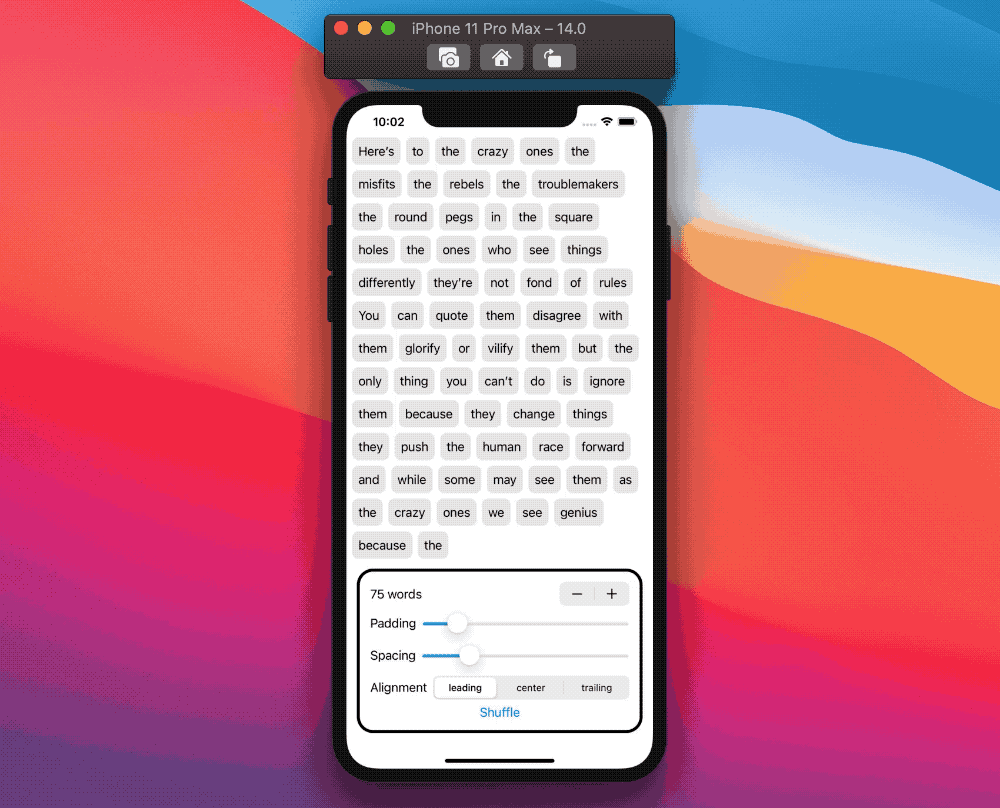I am trying to implement a tag list in SwiftUI but I'm unsure how to get it to wrap the tags to additional lines if the list overflows horizontally. I started with a string array called tags and within SwiftUI I loop through the array and create buttons as follows:
HStack{
ForEach(tags, id: \.self){tag in
Button(action: {}) {
HStack {
Text(tag)
Image(systemName: "xmark.circle")
}
}
.padding()
.foregroundColor(.white)
.background(Color.orange)
.cornerRadius(.infinity)
.lineLimit(1)
}
}
If the tags array is small it renders as follows:

However, if the array has more values it does this:

The behavior I am looking for is for the last tag (yellow) to wrap to the second line. I realize it is in an HStack, I was hoping I could add a call to lineLimit with a value of greater than one but it doesn't seem to change the behavior. If I change the outer HStack to a VStack, it puts each Button on a separate line, so still not quite the behavior I am trying create. Any guidance would be greatly appreciated.
Federico Zanetello shared a nice solution in his blog: Flexible layouts in SwiftUI.
The solution is a custom view called FlexibleView which computes the necessary Row's and HStack's to lay down the given elements and wrap them into multiple rows if needed.
struct _FlexibleView<Data: Collection, Content: View>: View where Data.Element: Hashable {
let availableWidth: CGFloat
let data: Data
let spacing: CGFloat
let alignment: HorizontalAlignment
let content: (Data.Element) -> Content
@State var elementsSize: [Data.Element: CGSize] = [:]
var body : some View {
VStack(alignment: alignment, spacing: spacing) {
ForEach(computeRows(), id: \.self) { rowElements in
HStack(spacing: spacing) {
ForEach(rowElements, id: \.self) { element in
content(element)
.fixedSize()
.readSize { size in
elementsSize[element] = size
}
}
}
}
}
}
func computeRows() -> [[Data.Element]] {
var rows: [[Data.Element]] = [[]]
var currentRow = 0
var remainingWidth = availableWidth
for element in data {
let elementSize = elementsSize[element, default: CGSize(width: availableWidth, height: 1)]
if remainingWidth - (elementSize.width + spacing) >= 0 {
rows[currentRow].append(element)
} else {
currentRow = currentRow + 1
rows.append([element])
remainingWidth = availableWidth
}
remainingWidth = remainingWidth - (elementSize.width + spacing)
}
return rows
}
}
Usage:
FlexibleView(
data: [
"Here’s", "to", "the", "crazy", "ones", "the", "misfits", "the", "rebels", "the", "troublemakers", "the", "round", "pegs", "in", "the", "square", "holes", "the", "ones", "who", "see", "things", "differently", "they’re", "not", "fond", "of", "rules"
],
spacing: 15,
alignment: .leading
) { item in
Text(verbatim: item)
.padding(8)
.background(
RoundedRectangle(cornerRadius: 8)
.fill(Color.gray.opacity(0.2))
)
}
.padding(.horizontal, model.padding)
}
Full code available at https://github.com/zntfdr/FiveStarsCodeSamples.

If you love us? You can donate to us via Paypal or buy me a coffee so we can maintain and grow! Thank you!
Donate Us With